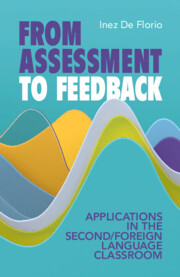Book contents
- From Assessment to Feedback
- From Assessment to Feedback
- Copyright page
- Contents
- TEFL Examples
- Introduction
- Part I Basic Concepts of Assessment and Feedback in the Foreign-Language Classroom
- 1 Feedback in Everyday Life and in Foreign-Language Education
- 2 Different Forms of Assessment and Feedback in Language Teaching and Learning
- 3 Evidence-Based or at Least Science-Oriented Research
- 4 The Evolution of Education and Foreign-Language Teaching as a Prerequisite of Feedback
- Part II Assessment and Feedback in Its Different Manifestations
- Part III Summative Assessment in Combination with Formative Feedback
- Glossary
- References
4 - The Evolution of Education and Foreign-Language Teaching as a Prerequisite of Feedback
from Part I - Basic Concepts of Assessment and Feedback in the Foreign-Language Classroom
Published online by Cambridge University Press: 19 January 2023
- From Assessment to Feedback
- From Assessment to Feedback
- Copyright page
- Contents
- TEFL Examples
- Introduction
- Part I Basic Concepts of Assessment and Feedback in the Foreign-Language Classroom
- 1 Feedback in Everyday Life and in Foreign-Language Education
- 2 Different Forms of Assessment and Feedback in Language Teaching and Learning
- 3 Evidence-Based or at Least Science-Oriented Research
- 4 The Evolution of Education and Foreign-Language Teaching as a Prerequisite of Feedback
- Part II Assessment and Feedback in Its Different Manifestations
- Part III Summative Assessment in Combination with Formative Feedback
- Glossary
- References
Summary
Feedback in its actual forms has gained momentum because many developments in teaching and learning in schools and in the foreign-language classroom in particular have facililtated the implementation of a feedback culture. In the last decades, education in schools has become more and more learner-oriented. On this basis, formative feedback practices have become more and more important and specified in order to help teachers and learners to overcome the concentration on the person of the teacher and on drill-based forms of instruction. Today, feedback is no longer a one-way road, but also reaches teachers and is complemented by various other forms of feedback. This general positive development was further promoted by the changes in foreign-language instruction from the Grammar-Translation-Method to Intercultural Communication, with the aim of coming as close to real-life settings as possible.
Keywords
- Type
- Chapter
- Information
- From Assessment to FeedbackApplications in the Second/Foreign Language Classroom, pp. 45 - 62Publisher: Cambridge University PressPrint publication year: 2023

